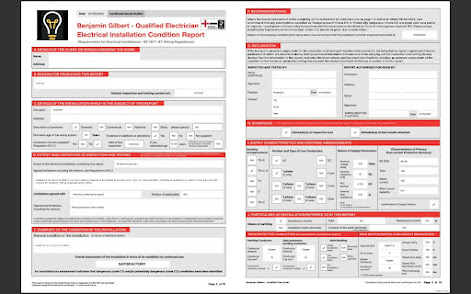The Legal Requirements to Provide an Electrical Condition Report
An Electrical Condition Report is an annual check and review of an electrical system. The main purpose of this report is to inspect and test an installation, identifying and documenting any issues that may impact electrical safety. This can be done before the system is installed and before it comes in use, or after the installation and use has been completed. The purpose of a report is not only to identify problems but also to allow for easy servicing and repair. A poorly performing electrical system can be very dangerous. It is often more economical and practical to fix any electrical problem before it becomes worse, rather than to repair a system that will continually fail.
Some reasons for a written electrical condition report could be to ensure that the installed appliances are safe to operate. The most common problems that cause electrics to function less than desired are overloads, tripping and shorts. These are often caused by overloading and tripping current, caused by faulty or dirty wiring. Other potential causes could be poor insulation, condensation, rust and dirt, and many other conditions.
It sets out specifications and regulations for both electrical installations and maintenance. It states that all electric installations, both in homes and businesses, must be installed according to the NICEIC. These regulations are not only designed to be a safety feature for electrical installations but also to save consumers money. By setting out standard operating procedures and requirements, and issuing specific licenses to electricians who adhere to these requirements, the NICEIC ensures that electricians and their employers, both commercial and residential, perform their job in compliance with established laws and regulations.
In addition to issuing licensing and NICEIC approval for electrical condition reports and inspections, the NICEIC also performs periodic inspections on installations to ensure that all equipment and wiring is in good working order and safe for use. Inspectors visit homes and businesses to examine electrical equipment and wiring; determine if there is a danger to residents or workers; and conduct tests to detect problems before they develop into larger issues that can pose a hazard to both life and property. All inspections are performed according to established guidelines that protect the public's safety. This helps to ensure the integrity of electrical installations and to ensure that the public remains safe from the possibility of electrical shock. Both qualified and non-qualified inspectors are expected to adhere to the same criteria and standards as the NOC.
The electrical condition report covers a wide variety of topics, some of which are more commonly known to electrical installation and maintenance professionals. One such topic is the installation and testing of circuit breaker systems. This is an extremely important inspection procedure since it is required under the law to test all circuit breakers, no matter how new they are. The purpose of this particular inspection is to identify and diagnose any high-risk areas within the electrical system that may be susceptible to electrical shock, fire, and smoke. It is also important to address issues with improper wiring as well as faulty connections and fuses.
Another area that is addressed in the annual electrical condition report is the operation of electric heating and air conditioning systems. Areas that are prone to develop potential risks include the furnace, ductwork, condensing vents and evaporator coils. All of these components are subjected to a variety of wear and tear, and are subject to conditions that can deteriorate their efficiency over time. A periodic inspection of these areas is necessary to ensure that they are operating at peak levels, and to prevent expensive repair bills. The electrical condition report will also address any issues that may be related to the operation of refrigeration systems, including the condition and repair of the water pump, and the condition of the compressors.
As part of the landlord/agent relationship, a commercial electric installation condition report is often included in the lease agreement. It is important for landlords to know what steps they should take to protect themselves, their business, and their tenants. Because many commercial buildings have non-standard features such as appliances and wiring, it is usually required that the landlord provides these things for the tenant to use in the home. Even if the landlord does not require a yearly electrical inspection, it is still a good practice to conduct one when a problem comes up that would potentially cost money to repair.
While the presence of a legal requirement to provide an electrical condition report might scare some away from installing certain types of appliances, it is simply a requirement that all landlords need to comply with. Some landlords prefer to do this on their own for peace of mind, but it is always better to know your options in this situation, and to be proactive in protecting yourself and your investment. While these reports are not often used for rent control purposes, they are still a useful document to have on hand when making decisions about the safety and efficiency of your property. In fact, these reports can even help you learn more about the regulations that govern these issues, and can help you understand whether or not a particular change would be beneficial to you or your tenants. While there may be some cases where it would be appropriate to hire a professional, it is still better to be well-informed so that you can make sound decisions for your property.



Comments
Post a Comment